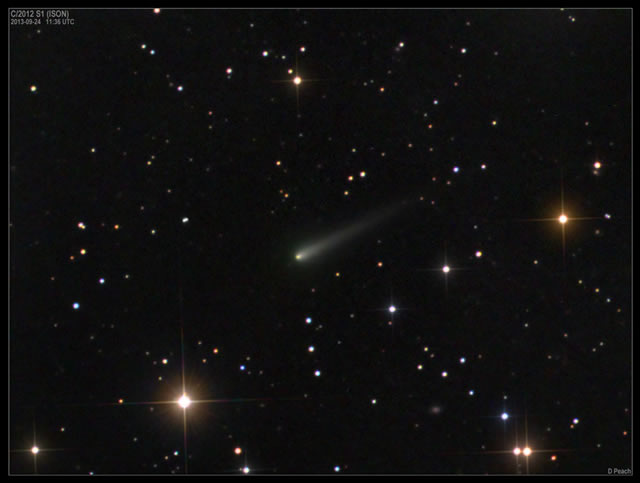
Image Credit & Copyright: Damian Peach
Quanto impressionante sarà la Cometa ISON? Nessuno è sicuro, ma purtroppo, come la cometa si avvicina al sistema solare interno, sembrerebbe apparire meno brillante rispetto a molte previsioni fatte in precedenza. Nella foto qui sopra ecco come la Cometa ISON appariva circa due settimane fa, e di come ha continuato a sviluppare la sua coda. La scorsa settimana la cometa è passata relativamente vicina a Marte ed è stata ripresa direttamente dal Mars Reconnaissance Orbiter.
Quando la Cometa ISON farà una immersione fino ad arrivare a pochi raggi solari della superficie del Sole, a fine novembre, potrebbe diventare più luminosa della Luna e con una coda lunga e fluente, o forse potrà apparire un po’ meno spettacolare, al momento è ancora una incognita. In entrambi i casi, gli appassionati del cielo sperano che la cometa possa sopravvivere durante il suo avvicinamento al sole, sapendo che nel caso sarà senz’altro uno spettacolo impressionante per come apparirà dalla Terra, almeno il resto dell’anno.
How impressive will Comet ISON become? No one is sure, but unfortunately, as the comet approaches the inner Solar System, it is brightening more slowly than many early predictions. Pictured above, Comet ISON is seen about two weeks ago as it continued to develop a tail. Last week the comet passed relatively close to Mars, and was directly imaged by the Mars Reconnaissance Orbiter.
When Comet ISON dives to within a few solar radii of the Sun’s surface in late November, it may become brighter than the Moon and sport a long and flowing tail – or it may appear somewhat less spectacular. Either way, sky enthusiasts hope that whatever comet parts survive will put on quite an impressive show, as viewed from Earth, through at least the rest of the year.
Source/Continue reading → apod.nasa.gov





















